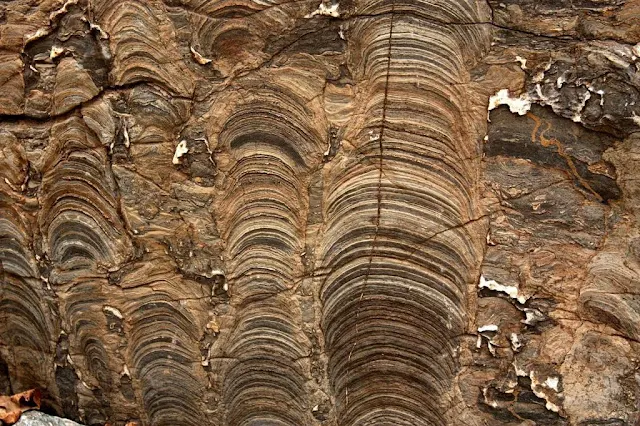Did Life Begin on Land Rather Than in the Sea?
 |
| Stromatolites. |
Stromatolites are round, multilayered mineral structures that range from the size of golf balls to weather balloons and represent the oldest evidence that there were living organisms on Earth 3.5 billion years ago.
Scientists who believed life began in the ocean thought these mineral formations had formed in shallow, salty seawater, just like living stromatolites in the World Heritage-listed area of Shark Bay, which is a two-day drive from the Pilbara.
But what Djokic discovered amid the strangling heat and blood-red rocks of the region was evidence that the stromatolites had not formed in salt water but instead in conditions more like the hot springs of Yellowstone.
The discovery pushed back the time for the emergence of microbial life on land by 580 million years and also bolstered a paradigm-shifting hypothesis laid out by UC Santa Cruz astrobiologists David Deamer and Bruce Damer: that life began, not in the sea, but on land.
"What she (Djokic) showed was that the oldest fossil evidence for life was in fresh water," said Deamer, a lanky 78-year-old who explored the region with Djokic, Damer, and Van Kranendonk in 2015. "It's a logical continuation to life beginning in a freshwater environment."
The model for life beginning on land rather than in the sea could not only reshape our idea about the origin of life and where else it might be, but even change the way we view ourselves.
The right conditions for life
For four decades, ever since the research vessel Alvin discovered deep-sea hydrothermal vents that were habitats for specialized bacteria and worms that looked like something out of a science-fiction novel, scientists have theorized that these mineral- and gas-pumping vents were just what was needed for life to begin.But Deamer, who describes himself as a scientist who loves playing with new ideas, thought the theory had flaws. For instance, molecules essential for the origin of life would be dispersed too quickly into a vast ocean, he thought, and salty seawater would inhibit some of the processes he knew are necessary for life to begin.
Deamer had spent the early part of his career studying the biophysics of membranes composed of soap-like molecules that form the microscopic boundaries of all living cells. Later, given a piece of the Murchison meteorite that had landed in Australia in 1969, Deamer found that the space rock also contained soap-like molecules nearly 5 billion years old that could form stable membranes. Still later, he demonstrated that membranes helped small molecules join together to form longer information-carrying molecules called polymers.
Trekking to volcanoes from Russia to Iceland and hiking through the Pilbara desert, Deamer and his colleagues observed volcanic activity that suggested the idea that hot springs provided the right environment for the beginning of life. Deamer even built a machine that simulated the heat, acidity, and wet-and-dry cycles of hot springs and installed it in his lab on the UC Santa Cruz campus.
Rethinking the timeline
In Deamer's vision, ancient Earth consisted of a huge ocean spotted with volcanic land masses. Rain would fall on the land, creating pools of fresh water that would be heated by geothermal energy and then cooled by runoff. Some of the key building blocks of life, created during the formation of our solar system, would have fallen to Earth and gathered in these pools, becoming concentrated enough to form more complex organic compounds.The edges of the pools would go through periods of wetting and drying as water levels rose and fell. During these periods of wet and dry, lipid membranes would first help stitch together the organic compounds called polymers and then form compartments that encapsulated different sets of these polymers. The membranes would act like incubators for the functions of life.
Deamer and his team believe the first life emerged from the natural production of vast numbers of such membrane-encased "protocells."
While there is still debate about whether life began on land or in the sea, the discovery of ancient microbial fossils in a place like the Pilbara shows that these geothermal areas -- full of energy and rich in the minerals necessary for life -- harbored living microorganisms far earlier than believed.
The search for life on other planets
According to Deamer and his colleagues, this discovery and their hot-springs-origins model also have implications for the search for life on other planets. If life began on land, then Mars, which was found to have a 3.65-billion-year-old hot spring deposits similar to those found in the Pilbara region of Australia, might be a good place to look.For Damer, the new "end-to-end hypothesis" of how life began on land offers something else: that the origin of life was not just a simple story of individual, competing cells. Rather that a plausible new vision of life's start could be a communal unit of protocells that survived and evolved through collaboration and sharing of innovation rather than strict competition.
"That," he said, "is a fundamental shift that might impact how we think of our world, ourselves, and our future: as dependent on collaboration as much as being driven by competition."
Sitting in his fourth-floor office on campus, Deamer smiled as he recounted the letter Charles Darwin wrote to a friend in 1871, which speculated that life might have begun in "some warm little pond."
That's not far off the mark, Deamer said, "except we call ours 'hot little puddles.'"
The above story is based on Materials provided by University of California - Santa Cruz. Original written by Peggy Townsend.
